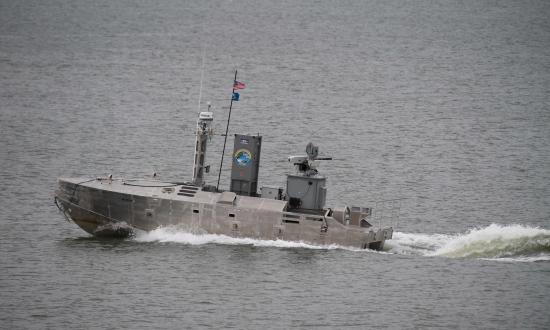Can the United States remain a maritime power without a significant maritime industrial base? Construction of a navy requires heavy industry, and the U.S. industrial base is shrinking. And it is unlikely there will ever be sufficient political will or public funds to restore it.
In light of these facts, the United States must create a strategy for post-industrial sea power. It must leverage both its alliances and its superiority in technology to maintain deterrence against possible near-peer adversaries, especially China.
Small Benefits, high cost of a Larger Fleet
Both Democratic and Republican administrations have called for an expansion of the Navy to either 355 or between 400 to 500 vessels.1 However, proposals for naval expansion measured in numbers of ships ignore changes in the balance of industrial power. According to the United Nations’ Conference on Trade and Development, in 2019, China built 35 percent of all ship tonnage, while the United States built 0.2 percent.2 The numbers vary year to year, but the ratio has stayed relatively constant. By tonnage, China could outbuild the United States 100 to 1. In an extended conflict, China would have a decisive advantage.
As a result, a larger U.S. fleet is unlikely to sway China’s strategic calculus. If China did not view a larger U.S. fleet as a deciding factor in a potential war, it would be, at best, only a limited check on Chinese behavior in times of peace.
In addition to providing little strategic benefit to the United States and its allies, fleet expansion would come at a high cost, requiring the United States to sacrifice other capabilities needed to compete with China both militarily and economically.
Between 2015 and 2019, the Navy failed to complete three-fourths of scheduled maintenance on time.3 While funds have been appropriated to improve and expand some shipyard facilities, a rapid fleet expansion would multiply the service’s maintenance problems.4 The solution would require significant additional investment in onshore facilities, which could be sound policy if ship maintenance were the only weak link in the defense industrial base. Unfortunately, this is not the case.
Each year, the National Defense Industrial Association produces a report on the health and readiness of the defense industry as a whole, with the results broken into several key sectors. One metric, the “percentage of excess capacity required to supply surge demand scenarios,” explores how easily the defense industrial base could respond to a sudden rise in demand. The 2020 report estimated U.S. shipbuilding and repair companies could feasibly double the number of ships delivered using current excess capacity. The situation for guided missiles is far worse. The report noted that doubling missile production would take 188 percent of excess industrial capacity.5 Even if the Navy could obtain the monies to shore up both its ship and guided missile programs to keep pace with Chinese naval production in peacetime, it could not compete with China in wartime industrial production.
A larger Navy also would likely be ineffective in broader lower-intensity competition. China has become increasingly adept at competing in the gray zone between war and peace. With tools ranging from maritime insurgency to economic pressure on its neighbors, it has become skilled in exercising its sway in Asia.6 Globally, its Belt and Road initiative continues to expand its influence in Africa and Europe. A larger U.S. fleet is of little value in this type of competition. If countries determine that the benefits of aligning with China outweigh those of aligning with the United States, a larger U.S. fleet could lose basing rights in countries that now are allies.
So what is the answer?
Foreign-Built and Foreign-based USVs
The United States must improve its options for basing and its interoperability with regional allies. One way to do this is for Congress and the Navy to support the commission of foreign-built and -based unmanned surface vessels (USVs). While 10 U.S.C. § 8679 states, “No vessel to be constructed for any of the armed forces, and no major component of the hull or superstructure of any such vessel, may be constructed in a foreign shipyard,” the law also provides that the President can waive this requirement if there is a national security interest.7 There is precedent for this. During the 1920s and 1930s, the U.S. Navy constructed several ships in Shanghai shipyards to patrol Chinese waters and counter Japanese aggression.8
Securing foreign basing rights for unmanned surface vessels is especially important given the complexity they introduce in maintenance and operations. With no sailors on board, maintenance cannot be done underway. USVs will likely need to operate near, and in concert with, a larger manned vessel for the foreseeable future. Basing could be easier with platforms built in an allied country.
Building USVs in yards in Japan and South Korea also would likely provide more capable USVs than could be built in U.S. yards at a similar price. As Chief of Naval Research Rear Admiral Lorin Selby noted in remarks to students at Stanford University:
We’ve only got a certain number of shipyards that can build these highly complex destroyers, submarines, aircraft carriers. . . . Let those yards build those exquisite things. . . . But we need to go the nontraditional yards down along the Gulf Coast, Pacific Northwest, other parts of (the) country even just boat builders, yacht builders. Let’s go to those folks to build some these unmanned things.9
While Admiral Selby did not mention the foreign construction of USVs—and it is unlikely any senior naval officer would publicly suggest the foreign construction of U.S. naval vessels of any type—it is worth laying out the benefits afforded by building USVs abroad.
A USV built in Japan or South Korea would likely be constructed by one of the ten largest shipbuilders in the world, taking advantage of their economies of scale. The builder would have experience in commercial vessels of a similar tonnage. In addition, both Japan and South Korea are world leaders in industrial robotics, which should reduce some of the challenges in the design, construction, and operation of robotic ships.
Foreign-built USVs would not be entirely foreign. Japan, South Korea, and Australia all operate ships equipped with the U.S.-made Aegis combat system, along with U.S. missiles and radar. Because a USV would have U.S.-built subsystems, a majority of dollars in a foreign-built USV would go to U.S. firms.
A USV equipped with sensors, vertical launch cells, and an Aegis data link would provide badly needed magazine depth in missiles and provide sensor coverage with the parent vessel emitting a low signature. Both these features would be invaluable in a conflict with China. Equally important, such a USV could be interoperable not only with U.S. ships, but also with the significant number of Aegis-equipped vessels operated by allies in the Pacific. There would even be the option, if an ally wanted to acquire their own USVs, to have U.S. and allied navies operate USVs of the same type.
Building the hulls of U.S. naval vessels in foreign countries may seem radical. It is not. U.S. F-35 aircraft fly with components made in nine partner countries.10 However, the foreign construction of unmanned vessels should not be seen as the first step to outsourcing manned naval construction. The U.S. maritime industrial base must be maintained as a hedge against shifting alliances.
Despite its advantages, foreign construction of USVs would likely draw opposition from traditional U.S. shipyards and their representatives in government. However, in the words of Admiral Hyman G. Rickover, “The Navy exists to defend our Nation—it has no other purpose. It serves as a shield in peace as well as in war; for, in final analysis, diplomacy rests upon the deployment and use of military force.”11 The only way the Navy can fulfill this purpose in a potential conflict with China is with the help the partnership of allies. There are few better ways to cement alliances than the shared production and operation of warships—even if those warships are unmanned.
1. Congressional Research Service, “Navy Force Structure and Shipbuilding Plans: Background and Issues for Congress,” 23 December 2020.
2. U.N. Conference on Trade and Development, “Ships Built by Country of Building, Annual,” Data Center, 2014-2019.
3. Government Accountability Office, “Navy Shipyards: Actions Needed to Address the Main Factors Causing Maintenance Delays for Aircraft Carriers and Submarines,” Report to Congressional Committees (August 2020).
4. Naval Sea Systems Command, “Building the Shipyards the Nation Needs,” Shipyard Infrastructure Optimization Program.
5. National Defense Industrial Association, “Vital Signs 2020: The Health and Readiness of the Defense Industrial Base.”
6. Hunter Stires, “The South China Sea Needs a ‘COIN’ Toss,” U.S. Naval Institute Proceedings 144, no. 5 (May 2019).
7. 10 USC Section 8679: Construction of vessels in foreign shipyards: prohibition.
8. James R. Holmes, “Misfit Ships on China’s Great River,” Naval History 33, no. 6 (December 2019).
9. RADM Lorin Shelby, USN, “The Navy and Modern War,” speech, Stanford, CA (through zoom), 29 October 2020.
10. Lockheed Martin, “Global Participation: The Centerpiece of 21st Century Security.”
11. ADM H. G. Rickover, USN, “The Role of Engineering in the Navy,” speech, Seattle, WA, 30 August 1974.






